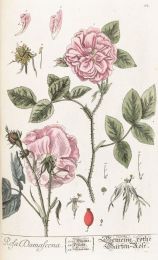In Love and War:
the Saga of the Rose
By Audrey Stallsmith

No more be grieved at that which thou hast done:
Roses have thorns, and silver fountains mud;
Clouds and eclipses stain both moon and sun,
And loathsome canker lives in sweetest bud.
William Shakespeare, Sonnet XXXV
For Valentine's Day, let's consider the bloom which has been the symbol of romantic love for centuries. A simple shifting of the letter E, after all, turns rose into Eros. The frequent poetic comparisons of females to the flower may not be altogether complimentary, though, since the rose is a notoriously thorny and temperamental plant!
This, however, only adds to "her" allure. As Spenser put it, "Sweet is the rose, but grows upon a brere. . ./ So every sweet with sowre is tempered still,/ That maketh it be coveted the more:/ For easy things that may be got at will,/ Most sorts of men doe set but little store."
The ancient Romans certainly couldn't get enough of this "difficult" Persian-born beauty. They strewed rose petals inches deep at their bacchanals, and Nero's fountains spouted rosewater. A few guests even smothered under a deluge of petals from a balcony--a literal example of the wealthy drowning in their own excess! A rose suspended over the table warned that everything said must remain secret or sub rosa.
Knights returning from the Crusades may have introduced the gallica rose to Britain. Gallica officinalis (a.k.a. the Apothecary Rose) was the Red Rose of Lancaster in the Wars of the Roses. The White Rose of York is believed to have been either alba semi-plena or alba Maxima.
In his version of those down-and-dirty conflicts, Shakespeare has Richard saying, "Let him that is a true-born gentleman/ And stands upon the honor of his birth. . ./ From off this brier pluck a white rose with me." Somerset retorts, "Let him that is no coward nor no flatterer,/ But dare maintain the party of the truth,/ Pluck a red rose from off this thorn with me."
Despite this bloody stain on her reputation, the Apothecary Rose was widely respected as a healer. In his 1597 herbal, Gerard recommended grinding the petals with sugar to "strengthen the heart and take away the shaking and trembling thereof." Bancke's Herbal prescribed honey of rose for "feeble, sick, phlegmatic, melancholy, and choleric people." John Heinerman touts rose petal tea as a treatment for two modern diseases: anoerexia and bulimia.
Otto of roses was supposedly discovered in the early 1600's in a canal filled with rosewater for a Persian princess's wedding feast. The happy couple noticed an oil separating from the water. When skimmed off, this ungent proved fit for a princess. And, considering that at least a hundred thousand roses were required for a butter-thick ounce of attar, a princess was one of the few who could afford it!
Poorer folks made do with potpourri-filled sweet bags, sweet waters, pastills, and pomanders. Rosaries may originally have been strung with either rose hips or rose-petal beads.
Rosewater is still used occasionally in cakes, but, during earlier centuries, roses flavored everything from jams and wines to poultry dishes. Dainty petal sandwiches delighted guests at Victorian teas.
Despite her delicate reputation, the rose can be one tough broad! Around here, if I wade through the poison ivy and briars of an abandoned farm, I am quite likely to stumble painfully across a cabbage rose or two, blooming away in the tall weeds--even after the house and barn have long disappeared.
Besides the "cabbages" (centifolias), the categories of old roses include gallicas, damasks, portlands, albas, mosses, bourbons, hybrid perpetuals, chinas, and rugosas. Three of my favorite heirloom varieties are the striped rosa Mundi (a mutation of the Apothecary Rose), wine-colored 'Tuscany' (a.k.a. 'Old Velvet'), and the luminous silky-pink 'Celsiana.'
In the Victorian Language of Flowers, the meaning differed depending on the variety or color of the bloom. A burgundy rose, for example, praised "unconscious beauty," and a china rose "beauty always new." A savvy suitor would, however, never send his sweetheart a yellow rose which signalled "decrease of love," or the York & Lancaster variety which declared "war."
To the Church, the queen of flowers often represented Mary, "queen of heaven." It also stood for the creation and life symbolized by the rose windows in Gothic cathedrals.
The rose has probably appeared on more coats of arms than any other emblem except the cross. In fact, it often appears with the cross, standing, perhaps, for the pain of the crucifixion and the glory of the resurrection. This flower teaches us that our most beautiful experiences may bloom from the thorny difficulties in our lives, and that we would not appreciate the joy so much without the pain which preceded it.
Perhaps T. S. Eliot had that thought in mind when he wrote, of the "Reality that is eternally underlying all things,": "All manner of things shall be well/ When the tongues of flame are in-folded/ Into the crowned Knot of the fire/ And the fire and the rose are one."
Rosa damascena image is from Herbarium Blackwellianum by Elizabeth Blackwell, courtesy of the Missouri Botanical Garden.








